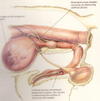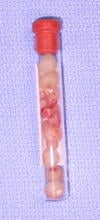When someone calls and says that their dog or cat is "constipated", we don’t just automatically hand out a list of laxatives over the phone. We always ask "What is your pet actually doing? Passing small hard stools? Squatting and straining a lot?" It is usually the latter. This is often the outward appearance of a pet who cannot empty his bladder, due to a blockage of some sort. Unlike constipation, it is a condition that rapidly becomes life-threatening
 Urethral blockage in tomcats is fairly common. Their urethra is very narrow [like Dale on "King of the Hill"] and has to make a sharp turn on the way out. When they have bladder problems, they can get clogged with very fine, sandy crystals, or even with just little plugs of mucus. This is a life-threatening situation. If the bladder cannot empty, then the kidneys shut down, and it doesn’t take much of that to put you over the edge. In prolonged cases, the bladder wall can become severely damaged, as well. Urethral blockage in male dogs is not uncommon, even though their urethra is pretty big (compared to a tomcat’s). Unfortunately, as in the above diagram, it not only has to make that 180-degree turn, but it runs into a bony channel that will not stretch. These situations move you to the front of the line, as they can become critical in a matter of hours (which have usually already passed before the owner gets hep to the problem).
Urethral blockage in tomcats is fairly common. Their urethra is very narrow [like Dale on "King of the Hill"] and has to make a sharp turn on the way out. When they have bladder problems, they can get clogged with very fine, sandy crystals, or even with just little plugs of mucus. This is a life-threatening situation. If the bladder cannot empty, then the kidneys shut down, and it doesn’t take much of that to put you over the edge. In prolonged cases, the bladder wall can become severely damaged, as well. Urethral blockage in male dogs is not uncommon, even though their urethra is pretty big (compared to a tomcat’s). Unfortunately, as in the above diagram, it not only has to make that 180-degree turn, but it runs into a bony channel that will not stretch. These situations move you to the front of the line, as they can become critical in a matter of hours (which have usually already passed before the owner gets hep to the problem).
Female dogs very rarely become obstructed with urinary stones. Their urethra is short, straight, and stretchy (a little bit, anyway). The stones are generally either too big to start down the pipe, or small enough to get through it. So when someone says that their female dog or cat is straining a lot, we don’t get too worked up. Maybe they are constipated, maybe it’s a bladder infection, maybe it’s a stone that will require surgical removal, but it’s not likely to be an emergency.
 On the other hand, sometimes one weirdly-shaped stone can lodge and cause a blockage. Or worse, start a pile-up, much like the stones in this tube… which were removed from just such a pile-up today. With a stack like that, you can’t just pass a catheter or flush them back up into the bladder. You wind up with the dog’s tummy open, the bladder up, out, and open, and catheters flushing saline from both ends. You float a couple of stones this way, then the other way, and finally they’re all out. It can be a bit of a tedious process. Of course, it’s not something you get a lot of practice at. This is only the third such case I’ve seen in 29 years.
On the other hand, sometimes one weirdly-shaped stone can lodge and cause a blockage. Or worse, start a pile-up, much like the stones in this tube… which were removed from just such a pile-up today. With a stack like that, you can’t just pass a catheter or flush them back up into the bladder. You wind up with the dog’s tummy open, the bladder up, out, and open, and catheters flushing saline from both ends. You float a couple of stones this way, then the other way, and finally they’re all out. It can be a bit of a tedious process. Of course, it’s not something you get a lot of practice at. This is only the third such case I’ve seen in 29 years.
These are probably struvite stones (Magnesium ammonium phosphate), though we won’t know for sure until the analysis comes back. In cats, they can be controlled with dietary alterations. In dogs, they are considered to always be secondary to a bladder infection. This gal will be taking antibiotics for a couple of weeks, based on her urine culture results. She will also be getting a urine specimen checked on a regular basis in the future.
Take-home message: pet is squatting and straining = get him (and her, too) to the veterinarian.


My 6 y/o female Boxer has had at least 4 consectutive bladder infections,last antibiotic was Batril. No masses, stones, or abnormalities on US. Any ideas?
Hello, Kathy,
There is always a reason, but sometimes it’s tough to figure out. I’m no urologist, but what they have told me in similar cases is to get a culture before starting the antibiotic, when finishing the antibiotic (two weeks minimum), and two weeks later.
You also look for urine retention, incomplete emptying of the bladder.
It’s good to encourage lots of fluid intake so that the bladder empties frequently to wash things down the urethra more often.
When I have cases like this I feel the need to consult a veterinary urologist (and I am certainly not a specialist).
Good luck.